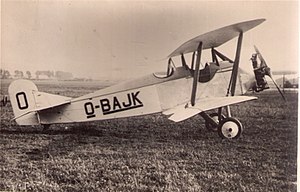TheStampe et Vertongen RSV.26/100,RSV.18/100,RSV.26/18,andSV.18were a family of two-seat touring aircraft designed byAlfred Renardand built byStampe et Vertongenin Belgium in the 1920s[1]and under license byGates Aircraftin the United States as theGates Convertiplane.[3]Originally designed as a biplane, a monoplane version soon followed, and the aircraft was eventually marketed as convertible between the two configurations.[4]Sometimes described as a lightened version of theRSV.26/140military trainer, the RSV.26/100 was actually a fresh design.[1]
| RSV.26/100, RSV.18/100, RSV.26/18, and SV-18 | |
|---|---|

| |
| Role | touring aircraft |
| National origin | Belgium |
| Manufacturer | Stampe et Vertongen,Gates Aircraft |
| Designer | Alfred Renard |
| First flight | 1928[1] |
| Number built | 11[2] |
Design and development
editIn 1928, Stampe et Vertongen contracted Alfred Renard to design an aircraft with which the firm could compete in the emerging touring aircraft market, which in Belgium was dominated by British types.[1]His response was a conventional, single-bay biplane with staggered wings of equal span.[5]The pilot and passenger sat in tandem open cockpits and power was provided by a radial engine in the nose.[5]The fixed undercarriage consisted of main units braced to one another, and a skid to support the tail.[5] At the time, Stampe et Vertongen designated their aircraft with two numbers: the wing area (measured in square metres) and the engine power (measured in horsepower).[6]Renard's new design had a wing area of 26 m² and was to be powered by a 75 kW (100 hp)Renard Type 100and was therefore designatedRSV.26/100.[1]Two years previously, the firm had introduced a training biplane for theBelgian Air Forcethat also had a wing area of 26 m2(280 sq ft); powered by a 75 kW (100 hp) engine, it had been designated theRSV.26/140.[7]The similar designations caused confusion in the aviation press, but Renard insisted that the RSV.26/140 and RSV.26/100 were two distinct aircraft.[8]
With monoplanes becoming more popular, Stampe et Vertongen considered the possibility of marketing a version of the RSV.26/100 in this configuration.[4]Renard was able to realise this design by removing the lower pair of wings and bracing the upper pair of wings to the fuselage with two struts on each side.[9]The resulting aircraft, having lost 8 m² of wing area, was now designated theRSV.18/100.[4]The monoplane version was a little faster than the biplane, but climbed a little more slowly.[4]With the differences between the two configurations so minimal that one could be converted to the other within one hour, Stampe et Vertongen decided to market the type as a convertible, theRSV.26/18.[4]
At the time,Wright Tuttle Motorswas negotiating a license to build theRenard Type 100engine in the United States.[10]The firm also purchased an RSV.26/100 and exported it, where it came to the attention of their client,Ivan R. Gates.[10]Gates was an exponent of light aviation and was so interested in the type that he not only purchased the first RSV.26/18, but a few weeks later, bought a license to produce it in the United States.[10]Gates established a factory atLong Island[3]and had engineer Nathan F. Vanderlip redesign the fuselage to change it from wooden construction to steel-tube construction.[10]However, only two aircraft were built[11]before theWall Street Crash of 1929ruined the company and Gates himself, who committed suicide as a result.[3]Three or four fuselages survived, one of which was used as a chicken coop as recently as 1975.[3]
The onset of the Great Depression also halted Stampe et Vertongen's production of the type.[1]AfterGeorge Ivanowjoined the firm, he made one final attempt to market the design, modifying the RSV.18/100 (OO-AKG) to use ade Havilland Gipsy IIIengine[12]and rebuilding the fuselage and empennage along similar lines to theSV.4.[11]Marketed first as theSV.18M(Modification) tourer,[12]then further modified and marketed as theSV.18MA(Modification Armée) fighter-trainer,[12]no further production ensued.
Variants
edit- RSV.26/100
- biplane version withRenard Type 100engine (5 built)[4]
- RSV.18/100
- monoplane version withRenard Type 100engine (1 built)[13]
- RSV.18/105
- monoplane version withCirrus Hermesengine (1 built)[14]
- SV.18M
- monoplane withde Havilland Gipsy IIIengine (1 converted from RSV.18/100)[12]
- SV.18MA
- militarised SV.18M (1 converted)[12]
- RSV.26/18
- convertible version withRenard Type 100engine (2 built)[11]
- Gates Convertiplane
- American variant of RSV.26/18 withRenard Type 100engine and fuselage of steel tube construction (2 built)[11]
Specifications (RSV.26/100)
editData fromJouhaut 1999, p.58
General characteristics
- Crew:1 pilot
- Capacity:1 passenger
- Length:7.10 m (23 ft 3 in)
- Wingspan:9.36 m (30 ft 8 in)
- Height:2.73 m (8 ft 11 in)
- Wing area:26 m2(280 sq ft)
- Empty weight:484 kg (1,060 lb)
- Gross weight:747 kg (1,640 lb)
- Powerplant:1 ×Renard Type 100,75 kW (100 hp)
Performance
- Maximum speed:168 km/h (104 mph, 90 kn)
- Range:640 km (400 mi, 350 nmi)
- Service ceiling:4,600 m (15,000 ft)
- Rate of climb:6.0 m/s (1,000 ft/min)
Notes
edit- ^abcdefJouhaud 1999, p.51
- ^Jouhaud 1999, p.53,56
- ^abcdJouhaud 1999, p.55
- ^abcdefJouhaud 1999, p.53
- ^abcJouhaud 1999, p.52
- ^Hauet 1984, p.9
- ^Jouhaud 1999, p.36
- ^Hauet 1984, p.22
- ^Jouhaud 1999, p.57
- ^abcdJouhaud 1999, p.54
- ^abcdJouhaud 1999, p.56
- ^abcdeDillien 2011, p.51
- ^OO-AKGis the only member of this family of aircraft that Jouhaud (1999, p.59) notes as having been built in permanent monoplane configuration.
- ^OO-APC(Hauet 1984, p.24). De Maeyer (1980, p.6) describes this as a conversion
References
edit- de Mayer, Paul (January–February 1980). "Built in Belgium: Part 1".Air-Britain Digest.32(1): 3–6.
- Dillien, André (2011)."Serie OO-AAA -> OO-AZZ".Registre historique de la matricule aéronautique civile belge.Retrieved2011-05-23.
- Hauet, André (1984).Les avions Renard.Brussels: Éditions AELR.
- The Illustrated Encyclopedia of Aircraft.London: Aerospace Publishing.
- Jouhaud, Reginald (1999).Les Avions Stampe.Amsterdam: Wimpel.
- Taylor, Michael J. H. (1989).Jane's Encyclopedia of Aviation.London: Studio Editions.